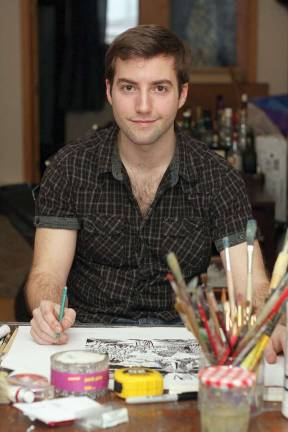From the Amazon to the Upper Manhattan

By Carly DeFilippo While the Upper East Side may not be the typical neighborhood for an up-and-coming artist, 26-year-old Harrison Love makes the most of his unconventional stomping grounds. He describes the Metropolitan Museum as his "church, a place to seek spiritual guidance" and cites the Frick as one of his favorite collections in the city. Though he admires the grand masters, Love's work tends toward abstraction, pulling from a range of influences and styles more similar to the contemporary collection of the Whitney Museum. Considering his background in illustration, it is surprising to learn that Love's favorite artwork is not that of high-octane contemporary galleries. "Current trends in art lend themselves more to entertainment than concept or context," Love said. "In a sense, artists are producing art that is all sugar, with little to no nutritional value." He is most interested in the work of socially relevant artists, referencing Ai Wei Wei, or those who challenge the experience of the observer, such as James Turrell, noting that both have managed to balance their popularity with a continued commitment to their artistic mission. The youngest member of an adventurous family of artists, Love spent much of his childhood in Europe, returning to the Northeast in his teens. But it was only in high school, after winning five Scholastic Gold Key Awards, that he ever considered a serious pursuit of art. Continuing to travel extensively, Love worked in Asia between semesters at the Rhode Island School of Design and eventually set his sights on more uncharted territory. It was his interest in the "ambiguous origins of our culture's creative evolution" that inspired Love's project to research the indigenous tribes of the Peruvian and Brazilian Amazon. Under the tutelage of shamans, he trained in traditional artistic practices, simultaneously becoming familiar with the plight of the native people. Increasingly disenfranchised and actively uprooted by the South American oil trade, these tribes stand on the brink of destruction. Their struggle inspired Love to set upon a new artistic mission: to celebrate, preserve and raise awareness about the region's creative tradition and cultural heritage. Love's current book project, Pahasqa Ñan ("The Hidden Way"), is the culmination of his creative research and a grateful homage to the tribes with whom he resided. Multiple methods of brightly-hued illustration relay tales inspired by native folklore, representing both the artist's perspective that "no one style is relevant or applicable to all subjects" and his range of skill. Those who attend Love's upcoming show, Compressing Culture, will witness the convergence of the diverse artistic techniques featured in his book. His research concerning the origin of creativity has led him to develop a style that calls upon the "universal balance of form, shape and line contained within all great paintings." The result is a rhythmic and dynamic blend of tribal pattern and cubistically influenced abstraction, a style he sustains across mediums and diverse color palettes. To view Love's most recent work, visit [www.harrisonlove.com](http://www.harrisonlove.com). Compressing Culture opens April 9 at the Greenpoint Gallery. For more information, visit [www.thegreenpointgallery.com.](http://www.thegreenpointgallery.com.)